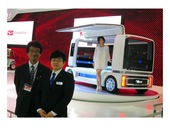Highlight
Hydrazine Hydrate Fuel Cell
Achievement/Results
This highlight focuses on the research lead by Dr Plamen Atanassov, and carried out by NSMS IGERT fellows, Ulises Martinez and Erika Vreeland (Cooley). This research highlight not only pertains to novel research, but also addresses a grand vision of technology transfer. It is a case study of technology transfer from a large university to a Japanese automotive company with practically no footprint in the US.
At the University of New Mexico (UNM), fuel cell catalyst research was performed in collaboration with Sandia National Laboratories and Los Alamos National Laboratory. Critical collaborations also occurred with two successful UNM materials technology spinoffs: Nano-Pore (an aerogel technology company) and Nano-Chem (later to become Superior Micro-Powders, later to become Cabot SMP – a division of Cabot Corp.), both having their business in Albuquerque. These companies were result of technology transfer from the UNM Center for Micro-Engineered Ceramics (later to continue as Center for Micro-Engineered Materials). This center operated for 20+ years a NSF Industry/University Research Center (I/UCRC), at the first two installments under the names cited above and later as a part of the NSF Ceramics & Composite Materials Center (CCMC), together with Rutgers University and later with Penn State.
The NSF I/UCRC model runs on company participation through modest membership organized through participation in an Industrial Advisory Board. There are strict IP rules and the success in running an operation like this is an art of its own. It brings however companies large (Intel, Motorola, Toyota), medium and small in usually non-competitive market interest to fund in a pre-competitive manner applied research topics. The technology development for fuel cell catalysts at UNM was supported through NSF I/UCRC and a succession of Department of Defense and Department of Energy grants, cultivated by industrially-funded memberships under NSF umbrella and forged in collaborations with Los Alamos National Labs and other Department of Energy national labs. Daihatsu Motor Company approached UNM team at a right time when the catalyst technology was ready for market introduction.
Address Goals
This research conducted by Dr Plamen Atanassov represents a collaborative alliance brings together researchers across Japan from academia and government, from private industry and non-profits and it has the participation of University of Houston, Gas Technology Institute (GTI) in Chicago and UNM.
The fuel for this unusual ZEV is hydrazine hydrate – a water solution of hydrazine that can be safely stored and used as a liquid fuel. As the fuel is oxidized on the anode of the fuel cell only nitrogen and water is produced making it a true ZEV. As a part of this partnership, IGERT fellows as part of a UNM team introduced a new type of hydrazine oxidation electrocatalyst, developed the anode catalysts for performance/manufacturability and participated in the scale-up operations by Cabot-SMP. UNM also worked with Daihatsu directly, with members of the CAFÉ alliance (such as University of Osaka) and in cooperation with GTI, the leading research, development and training organization serving energy and environmental markets, and on the cathode catalysts for oxygen reduction.
This direct hydrazine hydrate fuel cell uses a anion exchange polymer electrolyte membrane, as opposed to the proton-exchange membranes that are popular today. The membrane allows the use of non-platinum group metal (Non-PGM) catalysts for both oxidation of fuel on the anode and oxygen reduction on the cathode. The Non-PGM catalysts are stable in an alkaline media and thus can fully replace platinum catalyst. This technology was the basis of the Platinum Metal-free Liquid Fuel Car (PMfLFC) that was first introduced by Daihatsu at the 41st Tokyo Motor Show in December 2009. In just under three years, the UNM team developed the catalysts needed for the fully operational FC Show-Case, a concept car designed by Daihatsu Motor Corporation. The car premiered at the 42nd Tokyo Motor Show in December 2011 (see Fig. 2).
In the course of this project UNM has created independent and joined IP, participated in technology scale-up with one company and is involved in forward integration with another to ultimately deliver the technology. It operated in collaboration with universities and governmental labs in 3 countries in North America, Europe and Asia. Specifically, the technology created by IGERT Fellow Ulises Martinez is a catalyst that decomposes fuel electrochemically, meaning there is no burning involved. Nonprecious metals such as nickel are used to decompose hydrazine hydrate, which generates electricity. Instead of needing to use petroleum gasoline in a car, one could use such fuel cells to power the vehicle. This research resulted in a patent titled “Highly Active Metal Catalysts without Drawbacks for Fuel Cell Applications.”







